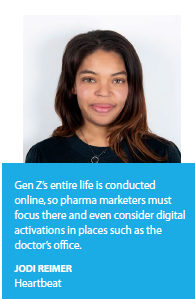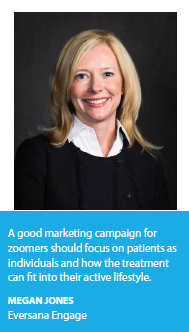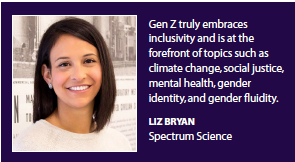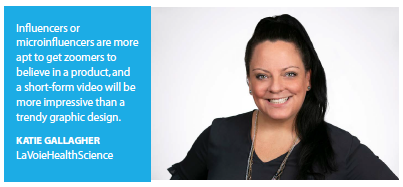Pharma needs to gear up for the 2 billion Gen Zers about to enter the marketplace.
If you’re looking for a snapshot of what Gen Z, or zoomers, means as an audience for your product, consider this: 16-year-old Swedish climate activist Greta Thunberg is a zoomer. Mari Copeny, who wrote a letter to President Obama asking him to meet to discuss the Flint water crisis, was 8 years old. Ms. Copeny, now 11, is a zoomer. So is Malala Yousafzai, the Pakistani activist for female education and the youngest Nobel Prize laureate. David Hogg, who survived the mass shooting at Marjory Stoneman Douglas High School in Parkland, Fla., leads efforts such as protests, marches, and boycotts to influence change in gun laws, wrote a book, and was named to Time magazine’s 100 Most Influential People in 2018, at the age of 18, is a zoomer.
Getting the picture?
 Zoomers although young, are a force to be reckoned with. Members of this generation don’t know the meaning of the word ‘can’t’ and they meet challenges head on with a grace and fierceness that defies their age. Born between 1995 and 2010, zoomers embrace diversity, social causes, and were practically born with a cell phone in their hand. Digital is their preferred communication channel, and they know how to wield its power.
Zoomers although young, are a force to be reckoned with. Members of this generation don’t know the meaning of the word ‘can’t’ and they meet challenges head on with a grace and fierceness that defies their age. Born between 1995 and 2010, zoomers embrace diversity, social causes, and were practically born with a cell phone in their hand. Digital is their preferred communication channel, and they know how to wield its power.
Zoomers are the most diverse generation in the United States so far; one in four is Hispanic, 14% are African American, and 6% are Asian, according to studies by Pew Research Center. “Zoomers are more diverse than any previous generation, shaping the way they interact with others and how they see themselves," says Liz Bryan, executive VP, Spectrum Science. “As a result, zoomers truly embrace inclusivity and is at the forefront of topics such as climate change, social justice, mental health, gender identity, and gender fluidity."
These purpose-driven consumers, according to an IBM consumer study, cite their health and wellness as their top priority; however, corporate sustainability is also extremely important and a major influence in the purchases they make. A study by the National Retail Federation and IBM reports 55% of zoomers choose brands that are eco-friendly and socially responsible.
Deloitte reports that zoomers don’t form opinions of a company solely based on the quality of its products or services but also on its ethics, practices, and social impact. Zoomers expect companies to be socially and environmentally responsible and expects brands to be “a representation of their values, their expectations of themselves and their peers," according to a study by Google.
The companies and brands that will appeal to zoomers must have a positive purpose and strong values that contribute to society and the world in some way.
Communicating that message clearly to zoomers will be vitally important, as well as using digital channels to convey corporate responsibility.
 “Zoomers came of age as smartphones became more sophisticated; therefore, they connect with the world primarily through mobile devices," says Katie Gallagher, account director, PR and marketing, LaVoieHealthScience. “They are more willing to engage with non-traditional marketing tactics such as YouTube and TikTok, are eager to show their independence, and are more frugal than millennials."
“Zoomers came of age as smartphones became more sophisticated; therefore, they connect with the world primarily through mobile devices," says Katie Gallagher, account director, PR and marketing, LaVoieHealthScience. “They are more willing to engage with non-traditional marketing tactics such as YouTube and TikTok, are eager to show their independence, and are more frugal than millennials."
Pharma may be thinking the upcoming generation is too young to focus on as a market right now, but zoomers will prove to be powerful consumers who care a great deal about their health. In just three years time, this group will become “the largest generation of consumers," according to Forbes. According to a study in PubMed, more than 20% of zoomers surveyed have taken a prescription medication in the last 30 days. Most common are medications for asthma, ADHD, contraceptives, antibiotics, antihistamines, and upper respiratory combinations. Marketers should start working on understanding zoomers and the power they have in the market to build brand loyalty in the future, our experts say.
The 74 million zoomers in the United States will have a strong hand in shaping the future and the market, and they have $44 billion in buying power, according to several sources. If their influence on home purchases is factored in, their spending power rockets to an estimated $143 billion to $200 billion, depending on the source.
Marketing to this younger generation needs to be more transparent, authentic, and organic. Pharma needs to be ready to reach this highly motivated, unconventional group on their level, and forget what worked for the Boomers, zoomers, and millennials. Marketing directly to them about the benefits of the product will not be enough to gain their loyalty. Drugmakers will need to have a transparent and authentic backstory to their corporate responsibility efforts, which translates into a meaningful purpose for the greater good — not just a showpiece on a website.
“Connecting with zoomers requires transparency and creativity, as well as providing them value-adding content and a unique user experience," Ms. Gallagher says. “With zoomers, there is a level-up approach to these efforts that is required to truly engage them. For example, authenticity to zoomers is key, and there is a fine line to walk when it comes to creativity."
Zoomers rely heavily on microinfluencers for making purchasing and other decisions, so pharma will need to incorporate them into their marketing strategies. In a study by Morning Consult, 52% of zoomers say they trust the influencers they follow. According to Rakuten Marketing, momentum for this trend is growing as brands are able to see measurable sales activity as a result of influencer campaigns.
Unlike celebrity spokespeople, microinfluencers speak directly to their followers in a relatable way. Reflecting this trend in social media, celebrity influencers make up just 28% of annual influencer spending compared with 40% for microinfluencers.
“Influencers or microinfluencers are more apt to get zoomers to believe in a product, and short-form videos will be more impressive than a trendy graphic design," Ms. Gallagher says. “They also want to see authentic emotion and are innately aware of how race, gender, and sexual orientation are depicted — or not — as these issues are more commonplace for this highly diverse generation."
“A good marketing campaign for zoomers should focus on patients as individuals and how the treatment can fit into their active lifestyle," says Megan Jones, chief operating officer, Eversana Engage. “Zoomers have unique experiences and expectations with the healthcare system. When we create a digital campaign, we need to use elements that show the product’s impact on them and their peer’s perception of the benefit more holistically. So instead of just showing product attributes, we’d also want to highlight how its impact brings a sense of relief to a spouse, parent, or caregiver."
Gen Z is highly community-driven, spots inauthentic content miles away, and is appreciative of brands that “walk the walk," Ms. Bryan adds. Brands targeting Gen Z must feel comfortable not being the center of attention and understand that what a product or drug represents for society, or even the world at large, is as important as quality or effectiveness.
“A campaign catering to Gen Z must remove any sense of binaries or rules," she says. “It requires raw, unfiltered content that places Gen Z itself at the center through an opportunity for co-creation."
Other interesting characteristics of members of Gen Z include an entrepreneurial side and lowered expectations of the need for a higher education. Growing up in the aftermath of the Great Recession, Generation Z doesn’t plan to work for someone else and risk getting laid off, as they witnessed what happened to their parents. In fact, 72% of teens in the United States say they want to start their own business one day; 61% of this group wants to start a business directly out of college. That is, if they go to college. They are not sure there is much value in a college education these days. As adept self-educators, 33% watch lessons online, 20% read textbooks on tablets, and 32% work with classmates online. Who needs to spend money and time on a formal education? Google it.
Make No Mistake: Zoomers Are Not Millennials
One detail that marketers who are looking to resonate with Gen Z must get right is to not mix them up with millennials. There are commonalities, but more importantly, vast differences between the two generations.
“The most common mistake we see is when marketers group both millennials and zoomers together into one target audience," Ms. Jones says.
While the term millennials may conjure up the image of “kids," they are not kids any longer. Millennials were born between 1981 and 1996. They are currently between 25 and 40 years old. Gen Z begins after 1996, so the oldest Gen Z is currently 24.
“This age gap drives differences in media preferences, overall experience, viewpoints, and even life outlook that are important from a marketing perspective," Ms. Bryan says.
“Each generation’s unique buying preferences and values must not be overlooked," Ms. Jones says. “Often marketers assume that both groups are simply technologically savvy and so a digital approach, for example, can be consistent. This approach will likely cause challenges to truly connect with both groups. And while they do share some characteristics, a customized approach to each should always be considered."
While millennials and Gen Z do share similar views on many issues, Gen Z prefers to create the change they want to see in the world using their hyperconnectivity in digital spaces, Ms. Bryan adds. “We’ve seen Gen Z build communities with avatars, create dance challenges on TikTok, and even organize to boycott political rallies — it’s inherent in how they engage with digital platforms," she says. “Brands marketing to Gen Z must invest time to understand this, demonstrate their values with clear action, and be open to co-creation to have a seat at the table."
Brands must demonstrate that they truly care by focusing on the value they can create for their audience by not focusing on the brand itself from the get-go. Brands make the mistake of thinking they need to be on the latest platforms to connect with Gen Z, however, creating an account on TikTok or Snapchat is not enough on its own. “Because Gen Z values authenticity and trust, marketing to them requires a clear content strategy that prioritizes engagement," Ms. Bryan says.
For example, doctors on TikTok — TikDocs — are making science and medicine easy to understand and accessible to the lives of Gen Z in a way that feels real and engaging. When that doesn’t feel attainable, regardless of channel, brands should partner with influencers who already have Gen Z’s attention and trust.
 While there is often confusion between the makeup of these two generational groups, digital consumption habits, buying priorities, and brand values are noticeable areas of difference, Ms. Jones says.
While there is often confusion between the makeup of these two generational groups, digital consumption habits, buying priorities, and brand values are noticeable areas of difference, Ms. Jones says.
Millennials grew up with a strong economy, and they prioritize the consumer experience, regardless of cost. On the other hand, zoomers have lived through an economic recession, so they often prioritize long-term value of a product before investing.
“We’ve learned, and research has backed, is that millennials are normally a lot more emotionally connected and loyal to their favorite brands, while zoomers tend to have a stronger interest based on their experience with the brand," Ms. Jones says.
“Zoomers want the brands they purchase to realistically mirror their values, morals, and lifestyles rather than promoting polished, overly curated content."
“By contrast, a campaign to millennials requires strong proof points across the patient journey so they can do their own research and reach a decision that feels uniquely right — even if that means taking an alternative path," Ms. Bryan says. “While convenience and personalization are important, getting the best treatment available is paramount."
According to Jodi Reimer, strategy director, Heartbeat, although there are many differences between these audiences, there are two big variants that should impact how marketers engage and move these audiences through their perspective journeys.
The first difference is that millennials are adopters of digital, whereas zoomers are native to digital. The lives of zoomers are almost completely online so, unlike the millennial, they will have a primarily digital ecosystem. Millennials will have a blend of all channels — both digital and non-digital — allowing different touchpoints for marketers to engage them. “But a zoomer’s entire life is conducted online, so pharma marketers must focus there and even consider digital activations in places like the doctor’s office," Ms. Reimer says.
The other major difference is the need for personalization, which is not just about an individual being able to customize a product — color, style, and shape — but rather for a brand or product to fundamentally fit with who they are as an individual: sexual orientation, social, political, racial stance, etc.
“Zoomers have changed the definition of personalization and therefore the approach must be to drive relevancy," Ms. Reimer says. “Today, it is more about understanding ‘who’ the audience is than ‘what’ they want."
If Ms. Reimer was creating a campaign for each of the two generations, they would look fundamentally different.
The zoomer campaign would be primarily digital, and even the offline supplemental  channels would have a digital activation component. Unlike millennials, the campaign’s message would hope to unify the community by encouraging equality, unity, and acceptance for all.
channels would have a digital activation component. Unlike millennials, the campaign’s message would hope to unify the community by encouraging equality, unity, and acceptance for all.
The version going to the millennial pool would be a 360-degree campaign pulled through both digital and non-digital channels. Its message would focus on making their lives better. It would use terms like “you" to put the millennial at the center of the campaign.
Ms. Jones agrees that each generation must be approached differently. “While both millennials and zoomers are natural digital users, zoomers have a greater need to see products and services turned into digital services or experiences," she says.
“Zoomers are often seen as being more socially conscious than any other generation, placing a high importance on what their peers think, which can directly affect their expectation of the patient experience."
An effective marketing campaign for a millennial on the other hand would deliver a seamless experience from access to treatment for the patient to feel loyalty to the brand.
According to an international study of zoomers conducted by The Center for Generational Kinetics, zoomers prefer brands that are authentic, with 82% saying they trust a company more if it uses images of real customers in its advertising, while 72% said they’re more likely to buy from a company that contributes to social causes. Product quality, positive ratings, and reviews and customer service are the top three characteristics that establish trust in a brand, the survey found.
“Marketers cannot fake their way through engaging this audience," Ms. Reimer says. “They demand transparency and full authenticity. They spend their time on apps that allow for free and open expression, anything less will not be tolerated, and they will let the marketer know it." To be successful with zoomers, pharma companies will have to be open about their successes and failures rather than trying to hide those events or results from their audiences.(PV)
~~~~~~~~~~~~~~~~~~~~~~~~~
7 Trends to Know About Zoomers
Trend 1: Gen Z was hit harder than any other generation in the workforce during COVID-19.
They were the most likely generation to lose their job, have a reduction in hours and pay, and to be reassigned to a job they were not hired to do.
Trend 2: Education has been upended for zoomers, and so have their education plans.
The State of Gen Z 2020 study reports that 40% of zoomers are actively reconsidering their college plan. In fact, of older zoomers, 40% were reconsidering their entire career path.
Trend 3: A majority — 58% — of zoomers believe in universal basic income, meaning providing all Americans with a livable amount of money, a big change even from millennials.
Trend 4: Zoomers will put tremendous pressure on brands to take action on social causes. The most important social causes to zoomers are climate change, the environment, racial equality, and social justice.
Trend 5: Zoomers are very practical with their money, particularly given their age.
Research shows zoomers are much more focused on saving and getting a great value for the money they spend rather than spending frivolously.
Trend 6: During the pandemic, zoomers trust healthcare workers over government leaders.
In one of the more generationally revealing findings, when it comes to trusting leaders during the pandemic, zoomers trusts healthcare workers significantly more than other types of leaders — from national and local government leaders to law enforcement.
Trend 7: Zoomers wants to make an impact on the world, starting now.
This generation believes it has the ability and responsibility to make the world a better place. In fact, 62% of zoomers believe their generation will bring positive change to the world.


















